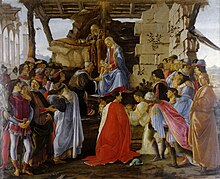Self-insertion
The examples and perspective in this article deal primarily with Western culture and do not represent a worldwide view of the subject. (February 2017) |

Self-insertion is a literary device in which a fictional character, who represents the real author of a work of fiction, appears as an idealized character within that fiction, either overtly or in disguise.[1]
In art, the equivalent is the inserted self-portrait, where the artist includes a self-portrait in a painting of a narrative subject. This has been a common artistic device since at least the European Renaissance.
Related concepts
This literary device should not be confused with a first-person narrator, an author surrogate,[clarification needed] or a character somewhat based on the author, whether the author included it intentionally or not. Many characters have been described as unintentional self-insertions, implying that their author is unconsciously using them as an author surrogate.[citation needed]
Examples
- The Razor's Edge by Somerset Maugham.
- Slaughterhouse-Five by Kurt Vonnegut[2][3]
- Breakfast of Champions by Kurt Vonnegut
- The French Lieutenant's Woman by John Fowles[4]
- Stan Lee in different Marvel comic books and movies
- Clive Cussler, author of Dirk Pitt novels, has inserted himself as a deus ex machina character in several of his books.[5]
- Gargantua and Pantagruel by François Rabelais, in the chapter "How Pantagruel with his tongue covered a whole army, and what the author saw in his mouth"
- Milton: A Poem in Two Books by William Blake
- The Divine Comedy by Dante Alighieri
- Randolph Carter in H.P. Lovecraft tales
- The title character of the Rush Revere series by Rush Limbaugh
- Bella Swan in the Twilight novel series by Stephenie Meyer
- Rayford Steele and Buck Williams in the Left Behind novel series by Tim LaHaye and Jerry B. Jenkins
- The title character of Jane Eyre by Charlotte Bronte
- I am the Messenger by Markus Zusak
- Homestuck by Andrew Hussie
- JPod by Douglas Coupland
- The Dark Tower VI: Song of Susannah by Stephen King
- A Series of Unfortunate Events by Lemony Snicket
- The Map and the Territory by Michel Houellebecq
- Frank Owen in The Ragged-Trousered Philanthropists by Robert Tressell
- Calvin's father in Calvin and Hobbes by Bill Watterson[6]
See also
References
- ^ Goetz, Sharon K. (1 April 2010). Terminus: Collected Papers on Harry Potter, 7-11 August 2008. Lulu.com. pp. 516–. ISBN 9780982680704. Retrieved 22 September 2014.
- ^ Mason, Fran (2009). The A to Z of Postmodernist Literature and Theater. Rowman & Littlefield. pp. 338–. ISBN 9780810868557. Retrieved 22 September 2014.
- ^ Klinkowitz, Jerome (1992). Structuring the Void: The Struggle for Subject in Contemporary American Fiction. Duke University Press. pp. 52–. ISBN 9780822312055. Retrieved 22 September 2014.
- ^ The Encyclopædia Britannica. Encyclopædia Britannica. 2014. Retrieved 17 November 2014.
- ^ "Dirk Pitt Revealed | An Official Web Site for Bestselling Adventure Novelist | Author Clive Cussler".
- ^ Bill Watterson. The complete Calvin and Hobbes Book One Introduction.
